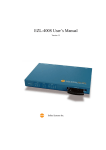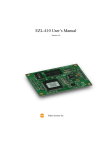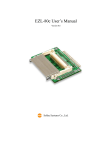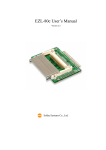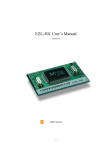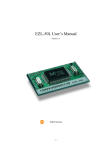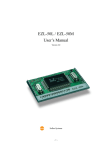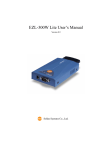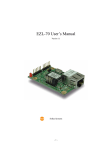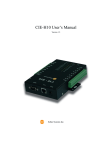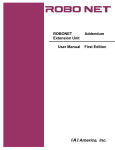Download EZP-250 User's Manual
Transcript
EZP-250 User’s Manual Version 1.3 Sollae System Co., Ltd To all residents of the European Union Important environmental information about this product This symbol on this unit or the package indicates that disposal of this unit after its lifecycle could harm the environment. Do not dispose of the unit as unsorted municipal waste; it should be brought to a specialized company for recycling. It is your responsibility to return this unit to your local recycling service. Respect your local environmental regulation. If in doubt, contact your local waste disposal authorities. -2- - Table of Contents 1. OVERVIEW..................................................................................................................... - 5 - 1.1. COMPONENTS..................................................................................................................- 5 - 1.2. SPECIFICATIONS ..............................................................................................................- 6 - 1.3. INTERFACE ......................................................................................................................- 6 - 1.3.1. Power ............................................................................................................................ - 7 - 1.3.2. Reset .............................................................................................................................. - 7 - 1.3.3. Serial Port Interface...................................................................................................... - 8 - 1.3.4. NC ................................................................................................................................. - 8 - 2. USING EZP-250............................................................................................................... - 9 - 2.1. OPERATION .....................................................................................................................- 9 - 2.2. EZP-250 COMMAND AND RESPONSE CODE FORMAT ....................................................- 11 - 2.2.1. Definitions................................................................................................................... - 11 - 2.2.2. Command Format ....................................................................................................... - 11 - 2.2.3. Response Code Format ............................................................................................... - 12 - 2.3. EZP-250 COMMANDS ...................................................................................................- 13 - 2.3.1. BR : Baud Rate of MT2 ............................................................................................... - 13 - 2.3.2. D0/D1 : DTR High/Low .............................................................................................. - 14 - 2.3.3. DN : PPP Down .......................................................................................................... - 14 - 2.3.4. E0/E1 : Local Echo Off/On ......................................................................................... - 14 - 2.3.5. EC : Escape Character ............................................................................................... - 14 - 2.3.6. FC : Flow Control....................................................................................................... - 15 - 2.3.7. ID/PW : PAP/CHAP User ID, Password..................................................................... - 15 - 2.3.8. LA : Local IP Address ................................................................................................. - 15 - 2.3.9. PA : Peer Host Address ............................................................................................... - 16 - 2.3.10. PP : Peer TCP/UDP Port ....................................................................................... - 16 - 2.3.11. PI : Product Information......................................................................................... - 16 - 2.3.12. SE : Send ICMP Echo Message (Ping) ................................................................... - 16 - 2.3.13. ST : EZL-250 Status ................................................................................................ - 17 - 2.3.14. T0/T1 : Trace Off/On............................................................................................... - 18 - 2.3.15. TA : TCP Accept...................................................................................................... - 18 - 2.3.16. TL : TCP Local Port ............................................................................................... - 18 - 2.3.17. TO : TCP Open ....................................................................................................... - 19 - 2.3.18. UL : UDP Local Port.............................................................................................. - 19 - 2.3.19. UP : PPP UP .......................................................................................................... - 19 - -3- 2.3.20. US : UDP Send ....................................................................................................... - 20 - 2.3.21. V0/V1 : Verbose Response Off/On........................................................................... - 21 - 2.3.22. HE : Help................................................................................................................ - 22 - 2.4. CLOSING TCP ...............................................................................................................- 22 - 2.4.1. TCP closed by external host........................................................................................ - 22 - 2.4.2. TCP closed by EZP-250 .............................................................................................. - 22 - 2.5. PPP DOWN ....................................................................................................................- 23 - 2.6. COMMUNICATION PHASES ............................................................................................- 23 - 3. OPERATION EXAMPLES .......................................................................................... - 25 - 3.1. CHANGING SETTING VALUES .........................................................................................- 25 - 3.2. EXAMPLE OF PPP CONNECTION FAIL ............................................................................- 25 - 3.3. EXAMPLE OF TCP CONNECTION FAIL ...........................................................................- 26 - 3.4. EXAMPLE OF TCP CONNECTION SUCCESS ....................................................................- 26 - 3.5. EXAMPLE OF UDP DATA SEND/RECEIVE .......................................................................- 27 - 4. CUSTOMER SERVICE, WARRANTY AND NOTES ON OPERATION............... - 28 - 4.1. CUSTOMER SERVICE......................................................................................................- 28 - 4.2. WARRANTY ...................................................................................................................- 28 - 4.2.1. Refund ......................................................................................................................... - 28 - 4.2.2. No-charge A/S ............................................................................................................. - 28 - 4.2.3. Charged A/S ................................................................................................................ - 28 - 4.3. NOTES ON OPERATION ..................................................................................................- 28 - 5. ORDERING INFORMATION ..................................................................................... - 30 - 6. REVISION HISTORY .................................................................................................. - 31 - -4- 1. Overview With the development of Internet technologies, the demands for data communication over Internet are in increasing trends. Data communication over Internet uses the Internet communication protocols TCP/IP. In other words, devices are connected to Internet by implementing TCP/IP protocols. Users can implement TCP/IP by implementing TCP/IP protocol by themselves, porting open TCP/IP, or using an Operating System (OS). However, these methods have many restrictions in terms of time, cost and technology. The ezTCP series of Serial ↔ TCP/IP protocol converters manufactured by Sollae Systems provide TCP/IP communication (Internet communication) “by simply connecting the serial ports”. ezTCP performs TCP/IP processing on the data received from the serial port and sends the result to the Internet network. In addition, it performs TCP/IP processing on the data received from the Internet network and sends the resulting raw data to the serial port. EZP-250 provides TCP/IP communication through PPP of ezTCP product groups. By connecting one serial port of EZL-250 to user device and the other to mobile phone, wireless modem, dial-up modem, or TRS terminal, users can be provided with TCP or UDP communication in the command format defined by Sollae System. EZP-250 supports TCP client mode, TCP server mode, UDP data transmission, PING transmission, etc., depending on the commands. 1.1. Components z EZP-250 body z EZP-250 evaluation board (option) z 5V adaptor (option) z RS232 serial cable (option) -5- 1.2. Specifications Power Input Voltage 2.7V - 5.5V Power 3.3V 4mA (idle) Consumption 5V 15mA (idle) Dimension 34mm x 20mm Weight About 4g Interface Serial port –DTE Serial port Modem Protocol Serial-DTE(TE2) 2mm pitch 1x10 connector Serial-Modem(MT2) 2mm pitch 1x10 connector UART (1200bps ~ 230400bps) - UART (1200bps ~ 230400bps) TCP, UDP, IP, ICMP, PPP, TELNET, PAP, CHAP ezterm Utilities pflash Socket communication program for test Program for firmware downloading through serial port 1.3. Interface -6- z JP1 No Description T1 Ground T2 There is no internal connection T3 Receive UART data from TE2 I ● T4 Transmit UART data to TE2 O ● T5 Ready To Receive from TE2 O T6 Clear To Send to TE2 I T7 Data Terminal Ready to TE2 O T8 Data Set Ready from TE2 I T9 Reset EZP-250 active HIGH I T10 VCC(2.7V – 5.5V) z I/O Mandatory ● ● JP2 No Description I/O Mandatory P1 VCC(2.7V – 5.5V) P2 Reset EZP-250 active HIGH I P3 Data Set Ready from MT2 I P4 Data Terminal Ready to MT2 O P5 Clear To Send to MT2 I P6 Ready To Receive from MT2 O ● P7 Transmit UART data to MT2 O ● P8 Receive UART data from MT2 I ● P9 There is no internal connection P10 Ground ● ● ● 1.3.1. Power 2.7V – 5.5V 1.3.2. Reset Reset is active HIGH. Since the reset ports T9 and P2 are connected internally, you may connect one of the two ports. -7- 1.3.3. Serial Port Interface EZP-250 provides two serial ports. One is connected to user terminal (TE2) and the other is connected to modem (MT2). If the amount of data to be transmitted is not large, it is enough to connect just RXD and TXD of UART in TE2, but you must connect the control lines of all serial ports of MT2. Both ports may be connected through the RS232 driver, depending on user applications. 1.3.4. NC The NC port should not be connected. -8- 2. Using EZP-250 2.1. Operation z EZP-250 is equipped with 2 serial ports. One is connected to the equipment for Internet communication and the other is connected to a mobile phone or modem. For the convenience of explanation, its components and ports are defined as follows: TE2 MT2 (Equipment or ◄► EZP-250 ◄► terminal) z (Mobile terminal, Modem) EZP-250 directly connects the serial ports of TE2 and MT2 upon power up. It transmits all data received from the serial port of TE2 to that of MT2 and vice versa. It can be assumed that the serial ports of TE2 and MT2 are connected directly. However, if the Escape-Character (hereinafter referred to as <ESC>) is entered through the serial port of TE2, EZP-250 recognized the characters from <ESC> to <CR> (hexadecimal 0x0d) as a command. The default value of <ESC> is ‘!’(hexadecimal 0x21), which can be changed to a character defined by user. z A mobile terminal that supports wireless Internet communication acts like a modem through the serial port. You can do dialing like a typical modem and can connect with the packet network using AT commands. An example to connect the packet network using a mobile terminal is shown below: AT OK AT+CRM=1 OK ATDT CONNECT z After call setup using the AT command above, TE2 transmits the UP command -9- to EZP-250 to perform PPP connection. After PPP connection has been accomplished normally, the mobile terminal can send/receive UDP data to/from the host connected to the Internet network using the US and UL commands. It can also send/receive TCP data to/from the host computer connected to the Internet network using the TO command. After TCP data communication is completed, the remote computer can close the TCP connection or EZP-250 can close the TCP connection using <ESC>. After TCP connection is cleared, you have to close the PPP connection and release the call. The procedure for TCP connection and TCP close is summarized below: 1. Make a call after modem setting 2. Connect PPP (UP) 3. Connect TCP (TO) 4. Send/receive data 5. Close TCP (ESC x 3) 6. PPP down (DN) 7. Call clear !001 ◀ EZP-250 booting !900 ◀ !E1 ▶ Input echo command !700 ◀ Command OK !V1 ▶ Display response message !700 COMMAND OK ◀ Command OK !PA 218.49.162.156 ▶ Set server IP address !700 COMMAND OK ◀ Command OK !PP 1470 ▶ Set server TCP port !700 COMMAND OK ◀ Command OK AT+CRM=150 ▶ CDMA setting OK ◀ AT command OK (in Modem) ATDT1501 ▶ Make a call CONNECT ◀ Call connection success (in Modem) !UP ▶ PPP connect command !710 PPP UP ◀ PPP connection success !TO ▶ TCP connect command !720 TCP CONNECTED ◀ TCP connection success - 10 - <data transfer> ◀▶ TCP data transfer !!! ▶ TCP close command !900 COMMAND STATE ◀ Command state transition message !820 TCP CLOSED ◀ TCP close message !DN ▶ PPP down command !810 PPP DOWN ◀ PPP down !D0 ▶ DTR High command (call clear) !700 COMMAND OK ◀ Command OK !D1 ▶ DTR Low command !700 COMMAND OK ◀ Command OK 2.2. EZP-250 Command and Response Code Format 2.2.1. Definitions The terms and definitions used in this document are listed below: Name Hexadecimal Description Value <ESC> The escape character of EZP-250. The default value after EZP-250 reset is ! (0x21). <CR> 0x0d Carriage Return <LF> 0x0a Line Feed <SP> 0x20 Space <OP> Optional data depending on commands. Other values not given in <> or () in the command format are ASCII values. For instance, BR is the two bytes of 0x42, 0x52. 2.2.2. Command Format A command of EZP-250 starts with <ESC> and finishes with <CR> and does not concern upper and lower cases. The default value of <ESC> is ! (0x21). You can change this value using the EC command. Since all parameters by commands are stored in the volatile memory, their values are cleared to the default values after EZP-250 reset. - 11 - z Command without option <ESC> Command (2byte) <CR> z Command with option <ESC> Command (2byte) <SP> Option (n byte) <CR> If a command is defined without option, the current value is to be displayed. (Example) !BR FE<CR> ▶ Set baud rate to the FE value. !700<CR><LF> ◀ Command OK !BR<CR> ▶ Confirm the baud rate value !FE<CR><LF> ◀ Display baud rate !700<CR><LF> ◀ Command OK 2.2.3. Response Code Format As shown below, response messages of EZP-250 are displayed in two formats, depending on their options: z Response message without option <ESC> Message string (3byte) <CR> <LF> z Response message with option <ESC> Message string (3byte) <SP> option (n byte) <CR> <LF> The response codes for commands are given as follows: Code Option strings when V1 Description command 001 EZP-250 booting 900 COMMAND STATE EZP-250 is ready to receive commands 700 COMMAND OK Command OK 710 PPP UP PPP connected 720 TCP CONNECTED TCP connected - 12 - 730 UDP SENT UDP data sent 740 ICMP RCVD Response to the ICMP echo request has been received 800 UNKNOWN COMMAND Invalid command 801 BAD STATE EZP-250 is in the bad state 810 PPP DOWN PPP connection fail or PPP closed 820 TCP CLOSED TCP connection fail or TCP closed 830 UDP TIMEOUT EZP-250 didn’t received during the given timeout 840 ICMP TIMEOUT Fail in receiving response to ICMP echo request 2.3. EZP-250 Commands 2.3.1. BR : Baud Rate of MT2 <ESC> BR <SP> <OP> (2byte) <CR> This command is used to change the baud rate of MT2 serial port. A two-digit hexadecimal value should be entered in the <OP> field. Baud rates are given as follows, depending on setting values: Setting Baud Rate Setting Baud Rate 40 1200bps F8 28800bps A0 2400bps FA 38400bps D0 4800bps FC 57600bps E8 9600bps FE 115200bps F0 14400bps FF 230400bps F4 19200bps It is not permitted to change the baud rate of TE2. e.g.) Change the baud rate of MT2 to 115200 bps <ESC>BR<SP>FE(0x46 0x45)<CR> - 13 - 2.3.2. D0/D1 : DTR High/Low <ESC> D0 <CR> <ESC> D1 <CR> Those commands are used to convert the DTR signal output of MT2 to High (D0) or Low (D1). The DTR output holds Low after a call has been connected and a short pulse created by High(D0)→Low(D1) is required to release the call forcibly. Basically, a mobile terminal is automatically disconnected when PPP is closed. However, some modems which are not disconnected automatically should be released using the DTR signal. 2.3.3. DN : PPP Down <ESC> DN <CR> This command is used to close the PPP connection. After TCP has been disconnected, TE2 has to disconnect the PPP connection using the DN command. 2.3.4. E0/E1 : Local Echo Off/On <ESC> E0 <CR> <ESC> E1 <CR> These commands are used set echo OFF(E0) or ON(E1) for input character strings. It is recommended to set echo to ON with the E1 command where it is necessary to check command input for the operation of EZP-250 in the process of product development. 2.3.5. EC : Escape Character - 14 - <ESC> EC <SP> <OP> (2byte) <CR> This command is used to change the <ESC> character. <OP> carries the two-digit hexadecimal value for an ASCII code of the desired <ESC> character. The ASCII value of the current ESC character is displayed when no parameter is entered. Since the value ranges can be from 00 through FF. 2.3.6. FC : Flow Control <ESC> FC <SP> <OP> (2byte) <CR> This command is used to set ON/OFF for hardware flow control of the serial port connected to TE2 or MT2. You have to set FC to 01, 10, and 11 for flow control on MT2, TE2 and both MT2 and TE2 respectively. The current value is displayed when no parameter is entered. Example) Flow control on both serial ports <ESC>FC 11<CR> 2.3.7. ID/PW : PAP/CHAP User ID, Password <ESC> ID <SP> <OP>(User ID) <CR> <ESC> PW <SP> <OP> <CR> These commands are used to set user ID and password required for PAP or CHAP authentication. Although authentication may be unnecessary for CDMA wireless network, it may be required for PPP server connection from wired telephone network through modem, depending on PPP server types or settings. 2.3.8. LA : Local IP Address <ESC> LA <SP> <OP>(IP Address) <CR> - 15 - This command is used when a fixed IP address is assigned to PPP network. Basically, this command may be unnecessary because IP addresses for PPP connection are allocated dynamically. Each number of IP address should separated with a dot like www.xxx.yyy.zzz. Only a decimal value is allowed for each number. 2.3.9. PA : Peer Host Address <ESC> PA <SP> <OP>(IP Address) <CR> This command is used to set an IP address of the server to be connected. Each number of IP address should be separated with a dot like www.xxx.yyy.zzz. Only a decimal value is allowed for each number. 2.3.10. PP : Peer TCP/UDP Port <ESC> PP <SP> <OP>(Port Number) <CR> This command is used to set a TCP/UDP port of the server. Only a decimal number is allowed for the port number. 2.3.11. PI : Product Information <ESC> PI <CR> This command displays the firmware version and internal software module of EZP-250. If there are any problems, you have to check the version and internal software module of your product with the PI command because a different module type may be used depending on its version. 2.3.12. SE : Send ICMP Echo Message (Ping) <ESC> SE <CR> - 16 - This command is used to check if the remote host works normally by receiving a message in response to the transmitted ICMP echo request (ping) message. This command is available after PPP connection. Where a response to ICMP echo request is received, the response code is displayed as follows: <ESC> 740 <CR> <LF> Where no response is received, the response code is displayed as follows: <ESC> 840 <CR> <LF> 2.3.13. ST : EZL-250 Status This command shows the PPP and TCP connection status of EZP-250. The output messages and their meanings are given below: 920 DEAD IWF or PPP down 921 ESTABLISH LCP is being connected 922 TERMINATE LCP connection is being closed 923 PAP PAP authentication is in progress 924 NETOWRK IP address is being allocated 925 INET Connected to the PPP server 930 CLOSED TCP closed 931 LISTEN Waiting for TCP connection 932 SYN_SENT TCP connection signal transmitted 933 SYN_RCVD TCP connection signal received 934 ESTABLISHED TCP connected 935 FIN_WAIT1 The TCP closed signal has been transmitted 936 FIN_WAIT2 ACK to the TCP closed signal has been received 937 CLOSE_WAIT The TCP closed signal has been received 938 CLOSING 939 LAST_ACK Waiting for acknowledgement to the TCP close signal 940 TIME_WAIT Waiting for confirming TCP closed The TCP closed signal has been transmitted/received concurrently - 17 - 2.3.14. T0/T1 : Trace Off/On <ESC> T0 <CR> <ESC> T1 <CR> These commands are used to set tracing PPP and TCP connection to OFF(T0) or ON(T1). The progress in PPP and TCP connection is displayed provided that Trace is set to ON. At this time, the output messages are the same as those displayed by the ST command. 2.3.15. TA : TCP Accept <ESC> TA <CR> This command is used to accept TCP connection from the remote host. The equipment connected to the PPP network typically acts as a client. The TA command of EZP-250 is used to run such equipment as a server. After PPP connection, if a TCP local port is set using the TL command and an external host attempts connection to the port, EZP-250 accepts the TCP connections and displays the following message: <ESC> 720 <CR> <LF> If the TO command is executed before TCP connection after running the TA command, the TA command is ignored and EZP-250 is connected to the external host as a client. After TCP connection, EZP-250 commands are not available because all data transmitted from TE2 is transferred to the host over TCP. 2.3.16. TL : TCP Local Port - 18 - <ESC> TL <SP> <OP>(Port Number) <CR> This command is used to set a port number for EZP-250 to act as a server. This command is used along with the TA command. 2.3.17. TO : TCP Open <ESC> TO <CR> This command is used to attempt connection with the TCP port of the remote host defined by PA command and PP command. The following message is displayed in case of TCP connection success: <ESC> 720 <CR> <LF> The following message is displayed in case of TCP connection fail: <ESC> 820 <CR> <LF> After TCP connection, EZP-250 commands are not available because all TCP data sent from TE2 is transferred to the host connected. 2.3.18. UL : UDP Local Port <ESC> UL <SP> <OP>(Port Number) <CR> This command is used to set a port to receive UDP data. When data is received through the UDP local port, EZP-250 converts the UDP data to raw data and transfers it to TE2. 2.3.19. UP : PPP UP <ESC> UP <CR> - 19 - This command is used to initiate PPP connection. This command is available after the CONNECT message has been displayed after sending the ATDT command to the modem. The following message is displayed in case of PPP connection success: <ESC> 710 <CR> <LF> The following message is displayed in case of connection fail: <ESC> 810 <CR> <LF> After PPP has been connected (PPP UP), UDP data can be transmitted or received using US and UL commands. In addition, it is possible to connect TCP using the TO or TA command and to perform ping test using the SE command. 2.3.20. US : UDP Send <ESC> US <SP> <Size> <SP> <Timeout> <CR> <Size> : Number of bytes to be transmitted by one block <Timeout> : Time interval to separate data blocks to be transmitted (Unit: 10 ms) This command is used to send UDP data to the IP address set by PA and the port set by PP. Unlike TCP, UDP transmits data by the block. Therefore, the number of bytes to be transmitted or its duration should be set to define a block. UDP data is transmitted, provided that one of the two parameters is fulfilled. <timeout> may be ignored (shaded field in the above figure) When UDP data is transmitted, the following message will be displayed: <ESC> 730 <CR> <LF> In case of UDP data transmission fail due to timeout, the following message will be displayed: <ESC> 830 <CR> <LF> - 20 - The following shows examples of US command: !US 5<CR> ▶ Command to send 5-byte UDP data !hello ▶ Send 5-byte data !730<CR><LF> ◀ UDP data transmission completed !US 3 100<CR> ▶ Command to send UDP data (block interval of 1 sec) No data transmitted for 1 sec !830<CR><LF> 2.3.21. ◀ UDP data transmission fail V0/V1 : Verbose Response Off/On <ESC> V0 <CR> <ESC> V1 <CR> These commands are used to display the response code followed by string so that those developers who use EZP-250 first can easily understand meanings of output messages. When Verbose is set to OFF(V0), all response codes are displayed in the following format: <ESC> Response Code <SP> String <CR> <LF> The response strings for commands are given as follows: Code string when V1 command Description 001 EZP-250 booting 900 COMMAND STATE EZP-250 is ready to receive commands 700 COMMAND OK Command OK 710 PPP UP PPP connected 720 TCP CONNECTED TCP connected 730 UDP SENT UDP data sent 740 ICMP RCVD Response to the ICMP echo request has been received 800 UNKNOWN COMMAND Invalid command - 21 - 801 BAD STATE EZP-250 is in the bad state 810 PPP DOWN PPP connection fail or PPP closed 820 TCP CLOSED TCP connection fail or TCP closed 830 UDP TIMEOUT EZP-250 didn’t received during the given timeout 840 2.3.22. ICMP TIMEOUT Fail in receiving response to ICMP echo request HE : Help <ESC> HE <CR> This command lists the EZP-250 commands. 2.4. Closing TCP To close TCP, the host being connected should be closed or TE2 should transmit three <ESC> characters to EZP-250. 2.4.1. TCP closed by external host TCP is closed when the external host being connected is closed. At this time, the following message is displayed: <ESC> 820 <CR> <LF> 2.4.2. TCP closed by EZP-250 First, EZP-250 has to transmit three <ESC> characters to notify closing TCP. The process to close TCP is similar to the "+++" escape sequence for a standard model. A guard time longer than 500ms is required before and after sending three <ESC> characters. That is, it is prohibited to send other characters for 500ms before/after sending the character string to close TCP. EZP-250 cannot recognize commands starting with <ESC> while TCP is connected but can recognize three <ESC> characters with a - 22 - guard time of 500ms. 2.5. PPP Down Unlike TCP, since PPP is rarely closed by the PPP server, it can be assumed that PPP is closed by EZP-250 or by call release due to communication fail. After TCP has been closed, TE2 should close PPP using the DN command. Typically, the time required for PPP down is about several tens of milliseconds. However, where call is cleared due to communication fail, more than 4 seconds may be required for PPP down and EZP-250 should wait for the "810" message displayed. Since the process for PPP down is simple compared with closing TCP, it is enough to check the down message of EZP-250. Since call may be released while transmitting/receiving TCP data, it is necessary to monitor the PPP down message transmitted from EZP-250. After normal PPP down, TE2 has to ensure that the call has been released by checking "NO CARRIER" or response to the "AT" command. There are some mobile terminals that would not be disconnected automatically, although most mobile terminals are automatically disconnected after PPP down. For such mobile terminals, call should released by creating a pulse of moderate duration for the DTR pin, using the D0→D1 command. Where the DTR pin is not connected, call may be released using the “+++” escape sequence. However, it is desirable to connected DTR line to mobile terminal because there are some mobile phone types that do not support this scheme. 2.6. Communication Phases EZP-250 processes serial port data depending on communication phases. The following table describes each communication phase of EZP-250: Communication Phase Description Before PPP Before PPP connect command (UP), all data except for the EZP-250 connect commands are transmitted to the opposite serial port. For example, the command data transferred from TE2 is transmitted to MT2 and vice versa. After PPP If the PPP connect command is received, TE2 handles only EZP-250 - 23 - connect commands and ignores others. MT2 recognizes only the HDLC data command format for PPP data processing. After PPP has been connected, UDP data can be transmitted or received and TCP connection is allowed. While TCP is connected, all data received from TE2 is processed by TCP/IP/PPP and transmitted to MT2. In addition, the TCP/IP/PPP data received from MT2 is processed and the resulting raw data is TCP connected transferred to TE2. To close TCP connection, the external host has to close the connection or TE2 has to send three <ESC> characters. At this time, the three <ESC> characters are transferred to the host connected. - 24 - 3. Operation Examples 3.1. Changing setting values !001<CR><LF> ◀ EZP-250 reset !900<CR><LF> ◀ !BR FE<CR> ▶ Set MT2 serial port to 115200bps !700<CR><LF> ◀ Command OK !BR<CR> ▶ Confirm the baud rate of MT2 serial port !FE<CR><LF> ◀ Display the setting value !700<CR><LF> ◀ Command OK !EC 23<CR> ▶ Change <ESC> to 0x23(#) #700<CR><LF> ◀ Command OK #ID eztcp<CR> ▶ Set PAP User ID to eztcp #700<CR><LF> ◀ Command OK #ID<CR> ▶ Confirm PAP User ID #eztcp<CR><LF> ◀ Display PAP User ID #700<CR><LF> ◀ Command OK #PW abcd<CR> ▶ Set PAP User Password to abcd #700<CR><LF> ◀ Command OK 3.2. Example of PPP Connection Fail !PA 211.22.78.210<CR> ▶ Set server IP !700<CR><LF> ◀ Command OK !PP 1470<CR> ▶ Set server TCP port !700<CR><LF> ◀ Command OK AT+CRM=1<CR> ▶ Set modem (Transferred to MT2) OK<CR><LF> ◀ Command OK(Data transferred from MT2) ATDT<CR> ▶ Dialing (Transmitted to MT2) CONNECT<CR><LF> ◀ Call connected (Data transferred from MT2) !UP<CR> ▶ PPP connect command !810<CR><LF> ◀ PPP connection fail NO CARRIER<CR><LF> ◀ Call release (Data transferred from MT2) - 25 - 3.3. Example of TCP Connection Fail !PA 211.22.78.210<CR> ▶ Set server IP !700<CR><LF> ◀ Command OK !PP 1470<CR> ▶ Set server TCP port !700<CR><LF> ◀ Command OK AT+CRM=1<CR> ▶ Set modem (Transferred to MT2) OK<CR><LF> ◀ Command OK(Data transferred from MT2) ATDT<CR> ▶ Dialing (Transmitted to MT2) CONNECT<CR><LF> ◀ Call connected (Data transferred from MT2) !UP<CR> ▶ PPP connect command !710<CR><LF> ◀ PPP connection success !TO<CR> ▶ TCP connect command !820<CR><LF> ◀ TCP connection fail !DN<CR> ▶ PPP down command !810<CR> ◀ PPP down NO CARRIER<CR><LF> ◀ Call release (Data transferred from MT2) 3.4. Example of TCP Connection Success !PA 211.22.78.210<CR> ▶ Set server IP !700<CR><LF> ◀ Command OK !PP 1470<CR> ▶ Set server TCP port !700<CR><LF> ◀ Command OK AT+CRM=1<CR> ▶ Set modem (Transferred to MT2) OK<CR><LF> ◀ Command OK(Data transferred from MT2) ATDT<CR> ▶ Dialing (Transmitted to MT2) CONNECT<CR><LF> ◀ Call connected (Data transferred from MT2) !UP<CR> ▶ PPP connect command !710<CR><LF> ◀ PPP connection success !TO<CR> ▶ TCP connect command !720<CR><LF> ◀ TCP connection success <data transfer> ◀▶ TCP data send/receive !!! ▶ Transition to the command mode with three <ESC> characters - 26 - !900<CR><LF> ◀ Transition to command mode !820<CR><LF> ◀ TCP closed !DN<CR> ▶ PPP down command !810<CR><LF> ◀ PPP down NO CARRIER<CR><LF> ◀ Call release (data from transferred from MT2) 3.5. Example of UDP Data Send/Receive !PA 211.22.78.210<CR> ▶ Set server IP !700<CR><LF> ◀ Command OK !PP 1470<CR> ▶ Set server port !700<CR><LF> ◀ Command OK !UL 2000<CR> ▶ Set UDP local port !700<CR><LF> ◀ Command OK AT+CRM=1<CR> ▶ Set modem (Transferred to MT2) OK<CR><LF> ◀ Command OK(Data transferred from MT2) ATDT<CR> ▶ Dialing (Transmitted to MT2) CONNECT<CR><LF> ◀ Call connected (Data transferred from MT2) !UP<CR> ▶ PPP connect command !710<CR><LF> ◀ PPP connection success !US 5 100<CR> ▶ UDP data send command <5 bytes data> ▶ 5 bytes transmitted within 1 sec !730<CR><LF> ◀ UDP transmission completed <3 bytes data> ◀ UDP data received through port 2000 !DN<CR> ▶ PPP down command !810<CR><LF> ◀ PPP down NO CARRIER<CR><LF> ◀ Call release (Data transferred from MT2) - 27 - 4. Customer Service, Warranty and Notes on Operation 4.1. Customer Service If you have any questions regarding operation of your product, visit the Customer Service FAQ page on Sollae System’s website or send us mail at the following address: Website address for customer service: http://www.sollae.co.kr Email address: [email protected] 4.2. Warranty 4.2.1. Refund You will be refunded if you decide to return your product within 2 weeks after purchasing. 4.2.2. No-charge A/S If there are any defects found in your product within one year after purchasing, repairing and exchange will be provided free of charge. However, if the product failure is due to user’s fault, repair service will be charged or the product will be replaced at user’s expense. 4.2.3. Charged A/S For product failures after expiry of the warranty period or resulting from user’s fault, repair service will be charged or the product will be replaced at user’s expense. 4.3. Notes on Operation • Sollae System is not responsible for product failures caused by user’s alteration of the product. • Specifications of the product are subject to change without prior notice for performance improvement. • Sollae System does not guarantee normal operation of the product under conditions beyond the specified limit. • Reverse engineering of the firmware and applications provided by Sollae System - 28 - should be prohibited. • The firmware and applications provided by Sollae System should not be used for purposes other than the specified use. • Do not use your product at an extremely cold or hot place or under an environment with severe mechanical vibration. • Do not use your product under a highly humid or oily environment. • Do not use your product under an environment involving corrosive or flammable gases. • Sollae System does not guarantee normal operation of the produce under noisy environment. • Do not use the product for applications that require exceptional quality and reliability associated with human injuries or accidents - aerospace, aircraft, health care, nuclear power, transportation, traffic and safety purposes. • Sollae System is not responsible for any accidents or damages caused by using your product. - 29 - 5. Ordering Information Part number Description Etc. EZP-250 EZP-250-E RoHS compliant Available from April 2006. - 30 - 6. Revision History Date Version Modification Nov.01.2005 1.1 The first release Dec.26.2005 1.2 Added Trash Mark for WEEE Mar.07.2006 1.3 Add response string table in V0/V1 command section. Add response string item in Response code format section Add Ordering Information - 31 -































